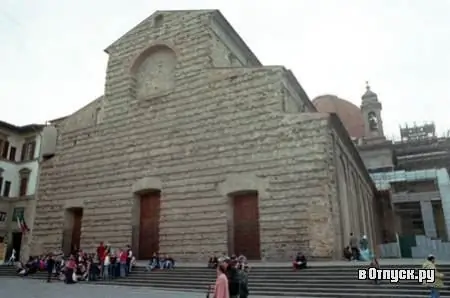
Description of the attraction
The Church of San Lorenzo is the oldest church in the city, since it was consecrated by St. Ambrose in 393. In 1060 it was rebuilt in the Romanesque style. The church owes its modern appearance to Brunelleschi (1423). Expressive and noble in its antiquity, the facade is devoid of marble cladding (Michelangelo's project for cladding the church with marble was never implemented).
In the interior of the church, attention is drawn to two bronze pulpits by Donatello, the Annunciation by Filippo Lippi in the Martelli Chapel and two sacristy in the transepts. The Medici Chapel building - a kind of Medici family crypt - rises behind the church of San Lorenzo. The entrance leads into a spacious, low-ceilinged hall decorated by Buontalenti. Here is the tomb of Cosimo the Elder, the tomb of Donatello, the tombs of the Lorraine and other great dukes. A modest stone slab is installed on the grave of the founder of the Medici dynasty - Cosimo the Elder.
From here you can climb to the large Chapel of Princes, which was conceived and carried out in large part by the architect Nigetti (with the participation of Buontalenti). Its construction began in 1602 and was completed only in the 18th century. The chapel, representing an octagon in plan, is completely finished with marble and solid stone in the Baroque style. Above the plinth, decorated with the coats of arms of the sixteen cities of the Grand Duchy of Tuscany, there are six arched sarcophagi of the Grand Dukes: Cosimo III, Francesco I, Cosimo I, Ferdinand I, Cosimo II and Ferdinand II; on two sarcophagi are statues of the dead, made by the sculptor Takka. A corridor connects the Chapel of Princes with the New Sacristy.
The old sacristy was designed by Brunelleschi and decorated by Donatello. The New Sacristy was created in 1520 by Michelangelo, who is also the author of the Medici tombs located here - Giuliano, Duke of Nemours, and Lorenzo, Duke of Urbino. The sarcophagus of the first is guarded by nude allegorical figures of Day and Night, the sarcophagus of the second - Evening and Morning.







